One of the solutions to the problem of heating a house can be pyrolysis boilers for heating solid fuels - efficient in operation and unpretentious in operation. However, the high cost of prefabricated heating devices makes a potential buyer think: shouldn't he try to make a pyrolysis boiler himself? For a hard-working person with technical skills, this is quite within the forces. Our article will help you understand how the combustion process takes place in a pyrolysis boiler for heating a private house, from what materials it can be mounted and how to connect it to the heating system.
Features of pyrolysis heating devices
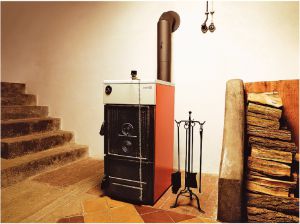
The main difference between a pyrolysis solid fuel heating boiler (gas generator) is the special principle of fuel combustion. If in ordinary boilers firewood or coal simply burns with an open flame, then the process is divided into two stages:
- Fuel is loaded into the combustion chamber and the fire is kindled. When the temperature exceeds 400 ° C, the process of pyrolysis begins - a slow smoldering of fuel with a lack of oxygen. This produces heat, smoke and pyrolysis gas, which includes carbon monoxide and various hydrocarbons.
- To transfer the boiler to operating mode, close the direct draft damper and turn on the fan. Gaseous pyrolysis products are forced out by a stream of primary air into the combustion chamber, where they are enriched with oxygen from the supply of heated secondary air. The mixture of pyrolysis gases and suspended particles completely burns out and gives up its thermal energy to the heat exchanger built into the boiler.
How economical and convenient pyrolysis heating boilers are, is confirmed by user reviews. Now they no longer need to get up at night to throw firewood. The next portion of fuel loaded into the boiler will slowly smolder from evening to late morning. The combustion efficiency is such that almost no ash remains, and only a light transparent smoke comes from the chimney.
For the normal course of the pyrolysis process, the boiler must be equipped with a fan, therefore it is necessary that the power supply in the house is uninterrupted.
Requirements for homemade pyrolysis boilers
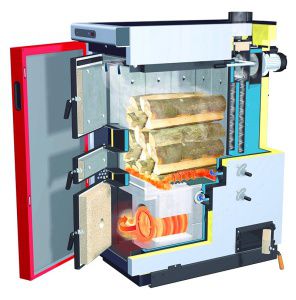
In order for a self-made pyrolysis heating boiler to outperform a conventional solid fuel boiler in efficiency, its design must meet strict requirements:
- the temperature in the furnace should be optimal (600–700 ° С), since it is under these conditions that the highest quality release of pyrolysis products occurs;
- the regulation of the combustion power should not significantly reduce the efficiency;
- the heating boiler must be suitable for long-term continuous fuel combustion;
- the casing of the combustion chamber of pyrolysis gases must be resistant to corrosion and capable of withstanding temperatures above 1200 ° C.
It is also desirable that a chamber for preliminary drying of wood raw materials be provided in the boiler design.
Technical characteristics that a homemade pyrolysis boiler should have for heating a private house:
| Technical specifications
| Unitrev. | For small houses
| For cottages |
| Power | kw | 15–25 | 35–50 |
| Efficiency | % | 80 | 85 |
| Maximum working pressure | bar | 1,8–2,0 | 3,0–4,5 |
| Max. heating area | m² | up to 200 | up to 500 |
| Heat exchanger water volume | l | 18–25 | 40–65 |
| Furnace volume | l | 70–100 | 200–300 |
The use of a home-made heating device is sometimes risky, because if the combustion process is improperly regulated, the so-called "pop" can occur - an explosion of pyrolysis gas.
Fuel for pyrolysis boilers
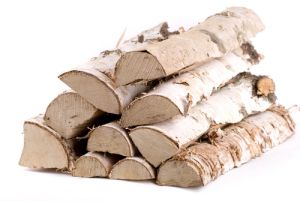
Of all types of fuel, firewood and various wood waste are best suited for the pyrolysis process. In addition, coal or peat can also be burned in pyrolysis boilers for heating a private house, but the efficiency will be somewhat lower.
The thickness of the logs does not really matter, and their length is limited only by the dimensions of the combustion chamber. The main condition is that rot and dust do not come across among them. If, in addition to firewood, sawdust and shavings are used for burning, their volume should not exceed 1/3 of the total fuel load.
Wood fuel must be dry, with a moisture content of no more than 20-25%. Otherwise, its combustion will be incomplete, heat transfer will decrease, and the chimney will become clogged with soot and tar.
Diy pyrolysis boiler
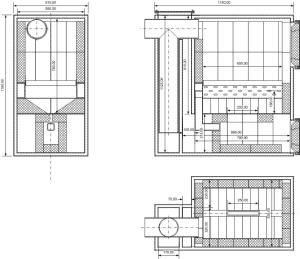
To do tocalving heating pyrolysis solid fuel, an amateur master will have to first study the available information on this issue.
As part of our article, we are able to give only general recommendations, and detailed drawings can be found on the Internet. It is also useful to look at the forums where experts exchange opinions.
According to their reviews, do-it-yourself pyrolysis heating boilers will still cost less than buying branded ones.
The power of the pyrolysis boiler is determined by several factors, and the main ones are: the overall dimensions of the product, the volume of the combustion chamber and the height of the primary air supply.
Any ready-made scheme of a heating system with a pyrolysis boiler will need to be finalized taking into account the specific conditions of your home.
Materials and manufacturing technology
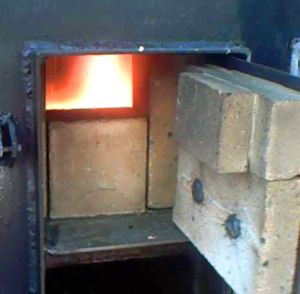
To make a pyrolysis heating boiler with your own hands you will need:
- electric welding machine and a good supply of electrodes;
- "Grinder" and to it at least 20 cutting wheels;
- steel 4mm, 3 sheets 1.25 × 2.5 m;
- steel 2 mm, one sheet;
- pipe 57 mm with a total length of 8 m;
- fireclay bricks, 12-14 pcs .;
- and some more small details.
Cutting metal and performing welding work is not an easy task. If it is not possible to do this on your own, you will have to invite a master.
The boiler doors must be tightly closed so that heat is not lost and smoke does not escape.
Testing the finished boiler
During the test, the shortcomings of a home-made heating boiler should be identified and ways to eliminate them should be determined. A well-assembled pyrolysis unit has the following properties:
- fuel flares up quite easily with natural draft;
- smoke does not escape from the upper door seal;
- the fan provides a stable air flow and does not make noise;
- the boiler goes into operation in 20-30 minutes;
- when the fan is turned on, the flame in the combustion chamber is strong and even;
- the process of burning pyrolysis gas is controllable;
- when the fan stops, there is no reverse thrust effect;
- the ratio of heat output to the amount of firewood consumed corresponds to the calculations.
If a home-made heating boiler demonstrates compliance with these parameters, it can be recognized as operational after eliminating the deficiencies found.
Diagrams for connecting a pyrolysis boiler to heating
The heat in the house depends on whether the heating system with a pyrolysis boiler is correctly arranged and whether the furnace mode is correct.All the nuances must be foreseen at the stage of drafting the project. House heating can be done both with hot water and air.
When developing a heating system, you must strictly follow the special recommendations and safety standards.
Water heating
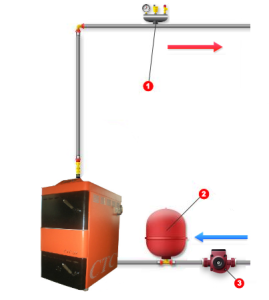
Installation of a pyrolysis solid fuel heating boiler should be carried out in a room specially designated for the boiler room. In addition to the boiler itself, such elements of the heating system as a circulation pump, shut-off valves, an expansion tank, sensors, thermometers and other devices should be placed here. In the same boiler room, it makes sense to equip a place for a woodpile of firewood near the boiler, so that you do not have to often go out for them in the cold.
Direct connection of the pyrolysis boiler to the heating system can be done in different ways. The following figure shows the simplest way to connect.
Other ways to connect a pyrolysis boiler to a water heating system:
- with mixing contour - an additional circuit and taps that regulate the amount of heated water are added to the above elements of the system;
- with a hydraulic arrow - this scheme works best in heating systems with several circuits;
- with storage tank - water is heated by its supply from the tank and allows optimizing the operation of the boiler even without electricity.
When choosing a connection scheme for a pyrolysis boiler heating system, it is advisable to calculate the cost of each option in order to find the best one among them.
Air heating
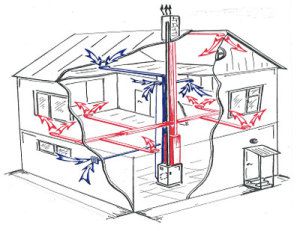
Homeowners use a pyrolysis air heating boiler most often not to heat the house, but for garages, warehouses, greenhouses and other utility rooms. The method of heating living rooms with heated air has not yet become widespread. But here, too, the use of a pyrolysis boiler could demonstrate its advantages. For example, an air heating system is especially relevant when the owners of a country house are concerned that the water heating system does not defrost during their long absence.
The system using pyrolysis boilers for air heating consists of one or more fans, temperature sensors, a control unit and a network of air ducts for transporting hot air to the heating places.
In whatever heating system pyrolysis solid fuel heating boilers are used, for their trouble-free operation it is necessary to insulate the chimney so that condensation does not form on its walls.
Finally
Analyzing reviews of pyrolysis heating boilers, one can get an impression of their undoubted advantages. In the context of a gradual rise in the price of natural gas, the decision to arrange a heating system with a self-made pyrolysis boiler becomes more and more justified. Many users are attracted by the autonomy of such a system and the ease of its operation.
Watch a video on how to make a fairly simple model of a pyrolysis boiler with your own hands:
For those who cannot connect to the central gas supply, pyrolysis solid fuel heating boilers will become reliable assistants in heating their homes. But if you decide to save money, then your decision will be to make the heating device yourself. Installation and connection of the pyrolysis boiler to the heating system will be accessible to people with engineering and locksmith skills.







